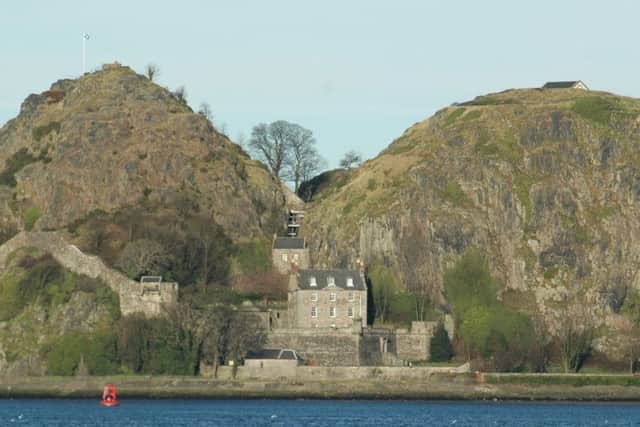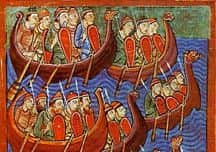Ivar the Boneless and a brutal Viking invasion of Scotland


As a Viking commander, he led a successful invasion of England and captured York, one of the centres of the Anglo-Saxon world, in 866 AD.
Even that grand prize wasn’t enough to satisfy his marauding armies and they soon switched their attentions to a small but wealthy kingdom further north.
Advertisement
Hide AdAdvertisement
Hide AdThere was just one problem. The rulers of the land in question occupied one of the strongest defensive positions anywhere in the British Isles.


Ivar’s Viking army would have to find a way to conquer Dumbarton Rock - a volcanic plug that rises 240ft above the River Clyde.
The rock of the Clyde
The imposing landmark was the capital of Alt Clut - ‘the rock of the Clyde’ - an ancient kingdom that stretched from Loch Lomond in the north to modern day Ayr in the south.
The people living on Alt Clut were Britons, once found across mainland Scotland and England. By the ninth century they had been pushed back to the edge of the British Isles as successive waves of Anglo-Saxons and Gaelic Celts settled in the post-Roman era.


Those living in Dumbarton - ‘fort of the Britons’ - spoke a Brythonic language similar to modern Welsh. The kingdom’s ruling class were related to powerful families across the ancient kingdoms collectively known as the Old North.
Archeological evidence found on Dumbarton Rock suggests Alt Clut had close trading links with Ireland and continental Europe.
Imported wines and fine jewellery were plentiful. But the kingdom’s most prized possession was Dumbarton Rock itself. It provided an ideal defensive position and allowed Alt Clut to control shipping along the Clyde - the only mass-transportation system in a world without roads.
‘The Boneless’


Advertisement
Hide AdAdvertisement
Hide AdIvar was reputed to be a ‘berserker’ - a Viking term for warriors who engaged in battle in a trance-like fury.
But the origins of his curious epithet, The Boneless, are unclear. Some believe it is a reference to impotence, while others claim it is an indication of his flexibility on the battlefield. One saga recorded Ivar as having “only cartilage was where bone should have been, but otherwise he grew tall and handsome and in wisdom he was the best of their children”.
If he did suffer from a medical condition, it did not prevent the warrior from inspiring his men to numerous military victories.
Icelandic sagas claim Ivar was the eldest son of Ragnar Lodbrok, a mythical warrior celebrated in several Old Norse poems.


An invasion plan
Ivar joined forces with Olaf the White, the Viking ruler of Dublin, to invade Alt Clut. His army marched north from York, while Olaf sailed his men across the Irish Sea and along the Clyde.
From their high position, the Britons would have been able to spot their enemy from several miles away and prepare their defences accordingly.
When the two armies met at the foot of the Rock, Ivar and Olaf took the decision to starve out the Britons.
Advertisement
Hide AdAdvertisement
Hide AdThe Vikings lay siege to the Rock for four months. The sagas claim its only well eventually dried up, leaving the Britons no choice but to surrender.
The spoils of war
Ivar, Olaf and their armies are said to have laid waste to the Rock. All of its buildings were destroyed and every item of value was taken.
Those Britons spared their lives were taken as slaves. The king of Alt Clud, Artgal mac Dumnagual, was taken prisoner.
The Vikings are said to have required some 200 longboats to transfer their men and the spoils of war back to Dublin.
One story suggests that Artgal was murdered in 872 in Dublin as a favour to Causantín mac Cináeda, the king of the Picts who was keen to exert his authority on Alt Clud.
The kingdom of Strathclyde
The sack of Dumbarton Rock did not spell the end for Alt Clud. The kingdom remainded a seperate entity and would not be formally merged into the Gaelic-speaking kingdom of Alba, which absorbed the the old Pictish lands, until the mid 11th century.
Govan, several miles downstream from Dumbarton, emerged as an important royal and religious centre for the Britons, and the kingdom gradually became known as Strathclyde.
Advertisement
Hide AdAdvertisement
Hide AdSeveral impressive Norse-style ‘hogback’ gravestones, dating from the ninth and 10th centuries, indicate Vikings did settle in the region.
By this time Ivar was long dead. The Annals of Ulster record him as dying in 873, from ’a sudden and horrible disease’.
Modern theories Ivar may have suffered from osteogenesis imperfecta or brittle bone disease.